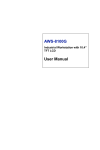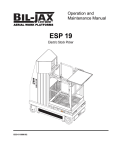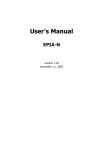Download AOpen GP1 Series User`s manual
Transcript
LV-667 Mini-ITX Motherboard User’s Manual Edition 1.2 2010/01/07 LV-667 User’s Manual Copyright Copyright 2004 - 2005. All rights reserved. This document is copyrighted and all rights are reserved. The information in this document is subject to change without prior notice to make improvements to the products. This document contains proprietary information and protected by copyright. No part of this document may be reproduced, copied, or translated in any form or any means without prior written permission of the manufacturer. All trademarks and/or registered trademarks contains in this document are property of their respective owners. Disclaimer The company shall not be liable for any incidental or consequential damages resulting from the performance or use of this product. The company does not issue a warranty of any kind, express or implied, including without limitation implied warranties of merchantability or fitness for a particular purpose. The company has the right to revise the manual or include changes in the specifications of the product described within it at any time without notice and without obligation to notify any person of such revision or changes. Trademark All trademarks are the property of their respective holders. Any questions please visit our website at http://www.commell.com.tw TU 2 UT LV-667 User’s Manual Packing List Please check the package before you starting setup the system Hardware: LV-667 series motherboard x 1 Cable Kit: 40-pin ATA100 IDE flat cable x 1 26-pin slim type floppy cable x 1 Serial ATA ribbon cable x 1 I/O Shield x 1 SDTV cable (LV-667T only) DVI output cable kit (LV-667D only) Other Accessories: YPrPb component cable (LV-667T only) Divers CD (including User’s Manual) x 1 3 LV-667 User’s Manual Index Chapter 1 <Introduction> ..................................................................................... 7 1.1 <Product Overview>................................................................................. 7 1.2 <Product Specification> ........................................................................... 8 1.3 <Mechanical Drawing>........................................................................... 11 1.4 <Block Diagram>.................................................................................... 12 Chapter 2 <Hardware Setup>............................................................................. 13 2.1 <Connector Location>............................................................................ 13 2.2 <Jumper Reference> ............................................................................. 14 2.3 <Connector Reference>......................................................................... 15 2.3.1 <Internal Connector>.................................................................. 15 2.3.2 <External Connector>................................................................. 15 2.4 <CPU and Memory Setup> .................................................................... 16 2.4.1< CPU>........................................................................................ 16 2.4.2 <Memory> .................................................................................. 16 2.5 <CMOS Setup> ...................................................................................... 17 2.6 <Enhanced IDE & CF Interface>............................................................ 18 2.7 <Serial ATA Interface>........................................................................... 19 2.8 <Floppy Port>......................................................................................... 20 2.9 <LAN Interface> ..................................................................................... 21 2.10 <Onboard Display Interface> ............................................................... 22 2.10.1 <Analog VGA Interface> .......................................................... 22 2.10.2 <DVI Interface (LV-667D only)> ............................................... 23 2.10.3<TV-out Interface (LV-667T only)>............................................ 24 2.11 <Onboard Audio Interface>.................................................................. 26 2.12 <USB2.0 & IEEE1394 Interface> ......................................................... 28 2.13 <GPIO Interface> ................................................................................. 30 2.14 <Serial Port> ........................................................................................ 31 4 LV-667 User’s Manual 2.15 <Power and Fan Connector> ............................................................... 32 2.15.1 <Power Input> .......................................................................... 32 2.15.2 <Fan Connector>...................................................................... 32 2.16 <Indicator and Switch>......................................................................... 33 Chapter 3 <System Configuration>................................................................... 35 3.1 <SATA RAID Configuration>.................................................................. 35 3.2 <Audio Configuration> ........................................................................... 37 3.3 <Display Configuration>......................................................................... 38 Chapter 4 <BIOS Setup> .................................................................................... 41 Appendix A <I/O Port Pin Assignment> ........................................................... 43 A.1 <IDE Port> ............................................................................................. 43 A.2 <Floppy Port> ........................................................................................ 45 A.3 <IrDA Port> ............................................................................................ 45 A.4 < VGA Port >.......................................................................................... 46 A.5 <Serial ATA Port>................................................................................... 46 A.6 <Serial Port> .......................................................................................... 46 A.8 <LAN Port> ............................................................................................ 47 A.9 <PS/2 Keyboard & Mouse Port>............................................................ 47 Appendix B <Flash BIOS>.................................................................................. 49 B.1 BIOS Auto Flash Tool ...................................................................... 49 B.2 Flash Method................................................................................... 49 Appendix C <System Resources> .................................................................... 51 C.1 <I/O Port Address Map>........................................................................ 51 C.2 <Memory Address Map> ....................................................................... 53 C.3 <System IRQ & DMA Resource> .......................................................... 54 C.3.1 <IRQ> ........................................................................................ 54 C.3.2 <DMA>....................................................................................... 55 Appendix D <Power Consumption Test> ......................................................... 57 Contact Information ............................................................................................ 58 5 LV-667 User’s Manual (The Page is Left For Blank) 6 LV-667 User’s Manual Introduction Chapter 1 <Introduction> 1.1 <Product Overview> LV-667 is the Mini-ITX motherboard based on VIA chipset. It integrates the last VIA embedded chipset for CN400 with VT8237, DDR266/333/400 SDRAM, and serial ATA with RAID to provide the economical embedded platform. VIA CN400 & VT8237 Chipset The board comes with the VIA last embedded chipset of CN400, supports DDR266/333/400 SDRAM, integrated the S3 Graphics UniChrome Pro IGP graphics core, hardware MPEG-2 and MPEG-4 acceleration and HDTV interface. The VT8237 provides the board to support Ultra V-Link (1GB/s) with CN400, two serial ATA ports with RAID array function, 6 x USB2.0 ports and 5.1 channel AC97 audio. Multimedia solution Based on VIA CN400 chipset, the board provides optional 18/24-bit LVDS, HDTV and DVI interface, which supports dual independent display with CRT. The board also has an optional mini-AGP interface to work with AGP 8x graphic card. Onboard AC97 codec provides the high quality of sound including 20-bit, stereo ADC and 6-channel stereo DACs. Dual LAN Interface LV-667 also comes with dual 10/100Mbps LAN interface, support boot-on-LAN and wake-on-LAN function. High Speed Hot-plug Interface Based on VIA VT8237, the board provides 6 USB2.0 interfaces with up to 480Mbps of transferring rate, 3 IEEE1394a interfaces with up to 400Mbps of transferring rate. Expanded UCR for remote Operating SETUP Bios Feature Expanded Universal Console Redirection (UCR) is a feature for monitoring POST messages and running Setup and an operation system from a remote serial terminal. Product Overview 7 LV-667 User’s Manual Introduction 1.2 <Product Specification> General Specification Form Factor CPU Memory Chipset BIOS Green Function Watchdog Timer Real Time Clock Enhanced IDE Serial ATA Mini-ITX motherboard Embedded VIA C3/Eden processor Ratio: 1.0GHz/800MHz L1/L2 Cache: 128/64KB Front side bus: 133MHz Fanless with Eden 800MHz processor Optional up to 1.2GHz with 200MHz FSB 1 x 184-pin DDR 266/333/400 SDRAM up to 1GB Unbufferred, none-ECC memory supported only VIA CN400 and VT8237 Phoenix-Award v6.00PG 4Mb PnP flash BIOS Power saving mode includes doze, standby and suspend modes. ACPI version 1.0 and APM version 1.2 compliant System reset programmable watchdog timer with 1 ~ 255 sec./min. of timeout value VIA VT8237 built-in RTC with lithium battery Enhanced IDE interface supports dual channels and up to 4 ATAPI devices at Ultra DMA133 One 40-pin and one 44-pin IDE port onboard VIA VT8237 integrates 2 Serial ATA interface RAID 0, 1 array Technology supported Multi-I/O Port Chipset Serial Port USB Port Parallel Port Floppy Port IrDA Port K/B & Mouse GPIO Hardware Monitor VIA VT8237 with Winbond W83697UF controller Two external & two internal RS-232 serial ports Six Hi-Speed USB 2.0 ports with 480Mbps of transfer rate None One slim type Floppy port One IrDA compliant Infrared interface supports SIR External PS/2 keyboard and mouse ports on rear I/O panel One 12-pin Digital I/O connector with 8-bit programmable I/O interface Fan speed, CPU temperature and voltage monitoring VGA Display Interface Chipset Core Frequency Memory Display Type Connector 8 VIA CN400 built-in S3 Graphics UniChrome Pro IGP graphics core 200MHz BIOS selectable 16/32/64MB shard with system memory CRT, LCD monitor with analog display External DB15 female connector on rear I/O panel Product Specification LV-667 User’s Manual Introduction Optional SDTV/HDTV Interface Codec TV system Output Interface Output Format VIA VT1625 NTSC (M and J) or PAL (B, D, G, H, I, M, N and Nc) TV system Composite, S-Video, Component (YPbPr) and D terminal SDTV output mode for 525p or 625p HDTV support for 1080i (D3) and 720p (D4) NTSC - 525i(480i) , 525p(480p) , PAL - 625i(576i) , 625p(576p) , HDTV - 1080i , 720p Resolution Optional DVI Interface Codec Standard Input Clock Resolution Output Interface VIA VT1632 Compliant with DVI 1.0 25 ~ 165MHz Up to 1600 x 1200 DVI-D Ethernet Interface Chipset Type Connector VIA VT6103 PHY & REALTEK 8100B 10Base-T / 100Base-TX auto-switching Fast Ethernet Full duplex, IEEE802.3U compliant Dual External RJ45 connectors with LED on rear I/O panel Audio Interface Chipset Interface Connector VIA VT1616 5.1 channel 3D audio with Line-in, Line-out and MIC-in External Audio phone jack for Line-out/Front, Line-in/Rear and MIC(stereo)-in/Center Onboard audio connector with pin header Onboard CD-IN connector Onboard 5-pin S/PDIF interface (optional output kit required) Expansive Interface Mini-AGP PCI IEEE1394 1 x AGP 8x interface supported (Optional) 1 x PCI slot supports up to two PCI devices through riser card VIA VT6306 controller integrated IEEE1394a supported Up to 400Mb/s of transferring rate Power and Environment Power Requirement Dimension Temperature Standard ATX 20-pin power supply 170 (L) x 170 (H) mm Operating within 0 ~ 60oC (32 ~ 140oF) Storage within -20 ~ 85oC (-4 ~ 185oF) Product Specification P P P P P P P P 9 LV-667 User’s Manual Introduction Software support Operation System Windows 98SE/ME, Windows 2000, Windows XP Windows CE 4.0 or later, Windows XP Embedded Linux (Fedora Core 1, Mandrake 9.2 and Red Hat 9.0) Ordering Code LV-667 VIA CN400 with Embedded C3 1.0GHz, VGA, SATA, 5.1CH Audio, CF, PCI, 4 x RS232, Dual LAN, Mini-AGP LV-667D VIA CN400 with Embedded C3 1.0GHz, VGA, SATA, 5.1CH Audio, CF, PCI, 4 x RS232, Dual LAN, DVI LV-667T VIA CN400 with Embedded C3 1.0GHz, VGA, SATA, 5.1CH Audio, CF, PCI, 4 x RS232, Dual LAN, HDTV LV-667E8 VIA CN400 with Embedded Eden ESP8000 processor, VGA, (Fanless) SATA, 5.1CH Audio, CF, PCI, 4 x RS232, Dual LAN, Mini-AGP LV-667E8D VIA CN400 with Embedded Eden ESP8000 processor, VGA, (Fanless) SATA, 5.1CH Audio, CF, PCI, 4 x RS232, Dual LAN, DVI LV-667E8T VIA CN400 with Embedded Eden ESP8000 processor, VGA, (Fanless) SATA, 5.1CH Audio, CF, PCI, 4 x RS232, Dual LAN, HDTV MA-ATI AGP 8x graphic card with ATI M10 GPU, 64MB DDR VRAM for Mini-AGP MA-1631X 18/24-bit LVDS add-on card for Mini-AGP 1. Please do not order other Mini-AGP modules excluded in the list for this board. 2. The specifications may be different as the actual production. For further product information please visit the website at http://www.commell.com.tw TU 10 UT Product Specification LV-667 User’s Manual Introduction 1.3 <Mechanical Drawing> (Measured by Inches) (Measured by Mini-meter) Product Specification 11 LV-667 User’s Manual Introduction 1.4 <Block Diagram> Embedded VIA C3 1.0GHz processor CRT/LCD Monitor Optional HDTV Optional DVI 1 x 184-pin Optional LVDS DDR266/333/400 Up to 1GB Optional AGP8x CN400 Ultra V-Link 1GB/s 6 x USB2.0 Ports 2 x SATA PCI VT6103 PHY VT8237 3 x IEEE1394a AC97 5.1CH Codec VT6306 LAN2 8100B 4 x Serial ports W83782D BIOS 1 x Floppy ports 8-bit GPIO Hardware Monitor IrDA 12 Product Specification LV-667 User’s Manual Hardware Setup Chapter 2 <Hardware Setup> 2.1 <Connector Location> CN_1394 CN_WOL CN_AUDIO CN_VGA CDIN DIMM CN_IR SPDIF PCI CN_DVI ATXPWR CN_HDTV CPUFAN CN_DIO CN_SDTV FDD CN_USB CN_COM3 MINI_AGP JFRNT CN_COM4 IDE1 IDE2 COM2 PS2 VGA COM1 SPEAKER Connector Location CN_SATA1 CN_SATA2 CF USB_RJ45_2 USB_RJ45_1 LINE_IN SYSFAN 1394_1 1394_2 MIC_IN 13 LV-667 User’s Manual Hardware Setup 2.2 <Jumper Reference> Jumper JRTC JDOM JLAN JCFSEL JC1/JC2/JC3/JC4 Function CMOS Operating/Clear Setting IDE1 Pin-20 voltage setting LAN2 Enable/Disable setting Compact Flash address mode setting Serial port output voltage setting JLAN JRTC 14 JDOM JCFSEL JC4/JC3/JC2/JC1 Jumper Reference LV-667 User’s Manual Hardware Setup 2.3 <Connector Reference> 2.3.1 <Internal Connector> Connector DIMM IDE1 IDE2 FDD CN_SATA1/2 ATXPWR CN_AUDIO CDIN SPDIF CN_DIO CN_USB CN_1394 CPUFAN SYSFAN CN_COM3 CN_COM4 CN_IR CN_WOL CF MINI_AGP CN_DVI CN_HDTV CN_SDTV JFRNT Function 184-pin DDR SDRAM DIMM 40-pin primary IDE connector 44-pin secondary IDE connector 26-pin slim type floppy connector 7-pin Serial ATA connector 20-pin power supply connector 5 x 2-pin audio connector 4-pin CD-ROM audio input connector Digital audio optical interface 6 x 2-pin digital I/O connector 5 x 2-pin USB connector 4 x 2-pin IEEE1394 connector 3-pin CPU cooler fan connector 3-pin system cooler fan connector 5 x 2-pin RS232 serial port 5 x 2-pin RS232 serial port 5-pin IrDA connector 3-pin wake on LAN connector Compact Flash Type II socket AGP 8x interface 13 x 2-pin DVI interface 5 x 2-pin HDTV interface 4 x 2-pin SDTV interface 14-pin switch/indicator connector Remark Standard Standard Standard Standard Standard Standard Standard LV-667 series Standard Standard Standard Standard LV-667 series Standard Standard Standard Standard Standard Standard LV-667/LV-667E8 LV-667D/LV-667E8D LV-667T/LV-667E8T LV-667T/LV-667E8T Standard 2.3.2 <External Connector> Connector VGA USB_RJ45_1/2 COM1/2 PS2 SPEAKER LINE_IN MIC_IN 1394_1/2 Function DB15 VGA connector Dual USB and RJ45 LAN connector Serial port connector PS/2 Keyboard/Mouse connector Audio Line-out port Audio Line-in port Audio Microphone input port IEEE1394 port Connector Reference Remark Standard Standard Standard Standard Standard Standard Standard Standard 15 LV-667 User’s Manual Hardware Setup 2.4 <CPU and Memory Setup> 2.4.1< CPU> The board supports Embedded VIA C3/Eden processor, default ratio is C3 1.0GHz with CPU cooler fan, Eden ESP8000 (800MHz) with heatsink only. 2.4.2 <Memory> The board supports one 184-pin DDR266/333/400 SDRAM and up to 1GB of capacity, only non-ECC, unbuffered memory is supported. DIMM 104-pin 80-pin Please check the pin number to match the socket side well before installing memory module. 16 CPU and Memory Setup LV-667 User’s Manual Hardware Setup 2.5 <CMOS Setup> The board’s data of CMOS can be setting in BIOS. If the board refuses to boot due to inappropriate CMOS settings, here is how to proceed to clear (reset) the CMOS to its default values. Jumper: JRTC Type: Onboard 3-pin jumper JRTC 1-2 2-3 Mode Clear CMOS Normal Operation Default setting JRTC 1 CMOS Setup 3 17 LV-667 User’s Manual Hardware Setup 2.6 <Enhanced IDE & CF Interface> The board supports two enhanced IDE interface, dual channel for 4 ATAPI devices with ATA133. Based on embedded application, the board has one 40-pin IDE connector with jumper selectable for pin-20 +5V supported, and one 44-pin IDE connector. The jumper JDOM is two-pin type for pin-20 supplied with +5V to apply the DOM (Disk on Module). The board also provides a Compact Flash Type II socket with jumper (JCFSEL) selectable slave/Master mode on secondary IDE channel. Jumper: JDOM Type: onboard 3-pin header JDOM Mode ON IDE1 pin-20 5V power supply enable OFF No 5V power supply on IDE1 pin-20 Default setting Jumper: JCFSEL Type: onboard 3-pin header JCFSEL Mode 1-2 Master 2-3 Slave Default setting CF JCFSEL 3 JDOM IDE1 40 IDE2 44 1 1 1 18 Enhanced IDE & CF Interface LV-667 User’s Manual Hardware Setup 2.7 <Serial ATA Interface> Based on VIA VT8237 Southbridge, the board supports two Serial ATA interfaces with RAID 0 and 1 array function. The following is the list of the specification of the Serial ATA. 1. Complies with Serial ATA Specification Revision 1.0 2. Dual Channel master mode PCI 3. On-chip two-channel Serial ATA (S-ATA) PHY for support of up to two S-ATA devices directly. 4. S-ATA drive transfer rate is capable of up to 150 MB/s per channel (serial speed of 1.5 Gbit/s). For more information please visit VIA website (www.via.com.tw) CN_SATA1 CN_SATA2 Serial ATA Interface 19 LV-667 User’s Manual Hardware Setup 2.8 <Floppy Port> The board provides a slim type floppy port; please use the 26-pin ribbon cable in the package to connect the floppy device. FDD Floppy rear side 1. 20 4. Lift up this plastic bar 5. Slot the cable in (Blue paste for outside) 6. Press back the plastic bar Lift up the brown plastic bar 2. Slot the cable in (Blue paste for 3. brown bar side) Press back the plastic bar Floppy Port LV-667 User’s Manual Hardware Setup 2.9 <LAN Interface> The board provides two 10/100Mbps LAN interfaces with VIA VT6103 PHY and REALTEK 8100B PCI controller, and compliant with standard IEEE 802.3 Ethernet interface for 100BASE-TX. The jumper of JLAN can let you enable/disable LAN2 with REALTEK 8100B. The CN_WOL is the interface for your PCI LAN card to wake the system up. Jumper: JLAN Type: Onboard 3-pin jumper JLAN 1-2 2-3 Mode Enable Disable Default setting Connector: CN_WOL Type: onboard 3-pin (1 x 3) wafer connector Pin 1 2 Description +5V Standby Ground 3 WOL-Ctrl CN_WOL 1 3 JLAN 3 1 LAN Interface 21 LV-667 User’s Manual Hardware Setup 2.10 <Onboard Display Interface> Based on VIA CN400, the board supports integrated S3 Graphics UniChrome Pro IGP graphics, with BIOS selectable 16/32/64MB shared with system memory for frame buffer. 2.10.1 <Analog VGA Interface> The board provides a DB15 VGA connector on the rear I/O panel, and one CN_VGA connector which enable you to connect the VGA interface with MA-ATI (Mini-AGP graphic card), thus you can have the same display output while applying a graphic card without additional output connector on chassis. Connector: CN_VGA Type: 16-pin (2 x 8) pin header (pitch = 2.0mm) Pin Description Pin Description 1 Red 2 Green 3 Blue 4 N/C 5 Ground 6 Ground 7 Ground 8 Ground 9 N/C 10 Ground 11 N/C 12 Data 13 HSYNC 14 VSYNC 15 Clock 16 EXCRT CN_VGA 16 1 22 Onboard Display Interface LV-667 User’s Manual Hardware Setup 2.10.2 <DVI Interface (LV-667D only)> The board provides optional DVI-D interface with VIA VT1632, compliant with DVI 1.0 standard, and supports dual display (clone or extended desktop) function with CRT. Connector: CN_DVI Connector type: 26-pin header connector (pitch = 2.54mm) Pin Number 1 3 5 7 9 11 13 15 17 19 21 23 25 Assignment TX1+ Ground TXC+ Ground N/C TX2+ Ground TX0+ N/C DDCDATA GND N/C N/C Pin Number 2 4 6 8 10 12 14 16 18 20 22 24 26 Assignment TX1Ground TXCPVDD N/C TX2Ground TX0HPDET DDCCLK N/C N/C N/C 26 1 CN_DVI Please use attached cable kit to connect DVI monitors Onboard Display Interface 23 LV-667 User’s Manual Hardware Setup 2.10.3<TV-out Interface (LV-667T only)> The board provides an HDTV and SDTV interface with VIA VT1625, supports PAL and NTSC of TV system, and dual display (clone or extended desktop) function with CRT. Connector: CN_SDTV Connector type: 8-pin header SDTV connector (pitch = 2.54mm) Pin Number 1 3 5 7 Assignment GND C GND CVBS Pin Number 2 4 6 8 Assignment Y GND GND GND Connector: CN_HDTV Connector type: 10-pin header HDTV connector (pitch = 2.54mm) Pin Number 1 3 5 7 9 Assignment GND DACB2 GND DACB3 LINE2 Pin Number 2 4 6 8 10 Assignment DACB1 LINE1 GND LINE3 +5V CN HDTV 10 1 8 CN SDTV 1 24 Onboard Display Interface LV-667 User’s Manual Hardware Setup To connect the TV set, please follow the diagram below to setup your system: YPrPb Component Cable (For HDTV) S-Video & Composite Cable (For SDTV) Onboard Display Interface 25 LV-667 User’s Manual Hardware Setup 2.11 <Onboard Audio Interface> The board provides the onboard AC97 5.1-channel audio interface with VIA VT1616, with three phone jacks on rear I/O panel for Line-out, Line-in, MIC(stereo)-in as 2-channel sound system, and Front, Rear, Center as 5.1-channel sound system. It also has one 10-pin header for additional audio output and 4-pin S/PDIF interface for optical/coaxial output. CN_AUDIO 10 1 4 1 SPDIF 4 1 CDIN Line-out Front 26 Line-in Rear MIC-in (system setup with 2-channel) Center (system setup with 5.1-channel) Onboard Audio Interface LV-667 User’s Manual Connector: CN_AUDIO Type: 10-pin (2 x 5) header (pitch = 2.00mm) Pin Description Pin 1 Line – Left 2 3 Line – Right 4 5 MIC2 6 7 N/C 8 9 Line Out – Right 10 Hardware Setup Description Ground MIC1 Ground Line Out – Left Ground Connector: CDIN (LV-667E8 series do not have this connector) Type: 4-pin header (pitch = 2.54mm) Pin Description 1 CD – Left 2 Ground 3 Ground 4 CD – Right Connector: SPDIF Type: 4-pin header (pitch = 2.54mm) Pin Description 1 +5V 2 N/C 3 SPDIFOUT 4 GND Onboard Audio Interface 27 LV-667 User’s Manual Hardware Setup 2.12 <USB2.0 & IEEE1394 Interface> Based on VIA VT8237, the board provides 6 USB2.0 ports, and 3 IEEE1394a with VIA VT6306. The USB2.0 interface provides up to 480Mbps of transferring rate, the IEEE1394a provides up to 400Mbps of transferring rate. Interface IEEE1394a USB2.0 Controller VIA VT6306 VIA VT8237 Transfer Rate 100/200/400Mb/s Up to 480Mb/s Output Voltage 12V 500mA 1394_1 1394_2 USB1/2/3/4 8 1 CN_1394 10 1 CN_USB 28 USB2.0 & IEEE1394 Interface LV-667 User’s Manual Connector: CN_1394 Type: 8-pin header (pitch = 2.00mm) Pin Description 1 CPWR 3 TPB25 TPA27 GND Hardware Setup Pin 2 4 6 8 Description GND TPB2+ TPA2+ GND Connector: CN_USB Type: 10-pin (5 x 2) header for USB5/6 Ports Pin Description Pin 1 VCC 2 3 Data04 5 Data0+ 6 7 Ground 8 9 Ground 10 Description VCC Data1Data1+ Ground N/C PS: The USB2.0 will be only active when you connecting with the USB2.0 devices, if you insert an USB1.1 device, the port will be changed to USB1.1 protocol automatically. The transferring rate of USB2.0 as 480Mbps is depending on device capacity, exact transferring rate may not be up to 480Mbps. USB2.0 & IEEE1394 Interface 29 LV-667 User’s Manual Hardware Setup 2.13 <GPIO Interface> The board provides a programmable 8-bit digital I/O interface; you can use this general purpose I/O port for system control like POS or KIOSK. Connector: CN_DIO Type: onboard 2 x 6-pin header, pitch=2.0mm Pin 1 3 5 7 9 11 Description Ground GP0 GP1 GP2 GP3 VCC Pin 2 4 6 8 10 12 Description Ground GP4 GP5 GP6 GP7 +12V CN_DIO 12 1 30 GPIO Interface LV-667 User’s Manual Hardware Setup 2.14 <Serial Port> The board provides four RS232 serial ports, with jumper selectable +5V/+12V output for COM3 and COM. Connector: CN_COM3/4 Type: 10-pin (5 x 2) header for COM3/4 Pin Description 1 DCD/+5 3 SO 5 GND 7 RTS 9 RI/+12V Pin 2 4 6 8 10 Description SIN DTR DSR CTS N/C Jumper: JC1/3 Type: Onboard 3-pin jumper JC1/3 Mode 1-2 COM3/4 pin-1 for +5V output 2-3 RIN1 Default setting Jumper: JC2/4 Type: Onboard 3-pin jumper JC2/4 Mode 1-2 COM3/4 pin-9 for +12V output 2-3 -XRI Default setting JC4/3/2/1 3 1 10 CN_COM3 CN_COM4 Serial Port 1 31 LV-667 User’s Manual Hardware Setup 2.15 <Power and Fan Connector> 2.15.1 <Power Input> Connector: ATXPWR Type: 20-pin ATX power connector PIN assignment 1 12V 2 5VSB 3 PWOK 4 GND 5 5V 6 GND 7 5V 8 GND 9 3.3V 10 3.3V 11 12 13 14 15 16 17 18 19 20 5V 5V -5V GND GND GND PSON GND -12 3.3V 2.15.2 <Fan Connector> Connector: CPUFAN (LV-667E8 series do not have this connector), SYSFAN Type: 3-pin fan wafer connector Pin Description Pin Description Pin Description 1 Ground 2 +12V 3 Fan Control ATXPWR 1 20 CPUFAN 1 3 SYSFAN 1 3 32 Power and Fan Connector LV-667 User’s Manual Hardware Setup 2.16 <Indicator and Switch> The JFRNT provides front control panel of the board, such as power button, reset and beeper, etc. Please check well before you connecting the cables on the chassis. Connector: JFRNT Type: onboard 14-pin (2 x 7) 2.54-pitch header Function Signal PIN Signal VCC 1 2 VCC Active 3 4 N/C Reset 5 6 GND GND 7 8 VCC N/C 9 10 N/C Power PWRBT 11 12 N/C Button GND 13 14 SPKIN IDE LED Function Power LED Reset Speaker JFRNT 14 1 Indicator and Switch 33 LV-667 User’s Manual (This Page is Left For Blank) 34 LV-667 User’s Manual System Configuration Chapter 3 <System Configuration> 3.1 <SATA RAID Configuration> The board supports two Serial ATA ports onboard, and supports RAID 0, 1 and JBOD disk array, the RAID 0, 1 and JBOD are specified below: RAID 0 (Stripping): Two hard drives operating as one drive for optimized data R/W performance. It needs two unused drives to build this operation. RAID 1 (Mirroring): Copies the data from first drive to second drive for data security, and if one drive fails, the system would access the applications to the workable drive. It needs two unused drives or one used and one unused drive to build this operation. The second drive must be the same or lager size than first one. JBOD (Span): As different as RAID 0, the JBOD combines two disks as one without any fault tolerance and I/O performance enhancement. To build Serial ATA disk array, please press <TAB> while booting up the system before entering OS, and follow the instructions to edit the RAID function. (Selectable Functions) (Option Instruction) (Disk Statement) SATA RAID Configuration 35 LV-667 User’s Manual System Configuration You also can edit disk array under OS, please install the VIA RAID Utility in the driver CD. (To getting start, please click here to learn more information) (Click here to build RAID 0) (Click here to build RAID JBOD) (Click here to build RAID 0) 36 SATA RAID Configuration LV-667 User’s Manual System Configuration 3.2 <Audio Configuration> The board provides 5.1 channel audio interface with driver installed, please install the VIA audio driver in the CD before getting start to enjoy the 5.1 channel sound system. (To enable 5.1-channel sound mode) Enable S/PDIF output, required optional S/PDIF cable kit for this function Audio Configuration 37 LV-667 User’s Manual System Configuration 3.3 <Display Configuration> The board provides onboard analog VGA interface, and optional digital display interface with HDTV, LVDS and DVI, please install the VIA video driver before enjoy the vivid display. Based on the VIA CN400 with S3 UniChrome Pro graphic, the board provides dual display function for clone or extended desktop modes with secondary display device attached. After installing video driver, please launch the desktop display properties. Please select each device to configure the resolution and color bit. For secondary display device, you have two options selectable. For more display properties setting, please click “Advanced” button. 38 Display Configuration LV-667 User’s Manual System Configuration Please select S3Display for advanced device setting. Connected Devices Click check box to enable/disable device Specified display setup When you set dual display clone mode, you’ll see the same screen display on two devices. When you set the dual display for extended desktop mode, you can have the independent desktop on the second device. Display Configuration 39 LV-667 User’s Manual (This Page is Left for Blank) 40 LV-667 User’s Manual BIOS Setup Chapter 4 <BIOS Setup> The motherboard uses the Award BIOS for the system configuration. The Award BIOS in the single board computer is a customized version of the industrial standard BIOS for IBM PC AT-compatible computers. It supports Intel x86 and compatible CPU architecture based processors and computers. The BIOS provides critical low-level support for the system central processing, memory and I/O sub-systems. The BIOS setup program of the single board computer let the customers modify the basic configuration setting. The settings are stored in a dedicated battery-backed memory, NVRAM, retains the information when the power is turned off. If the battery runs out of the power, then the settings of BIOS will come back to the default setting. The BIOS section of the manual is subject to change without notice and is provided here for reference purpose only. The settings and configurations of the BIOS are current at the time of print, and therefore they may not be exactly the same as that displayed on your screen. To activate CMOS Setup program, press <DEL> key immediately after you turn on the system. The following message “Press DEL to enter SETUP” should appear in the lower left hand corner of your screen. When you enter the CMOS Setup Utility, the Main Menu will be displayed as Figure 4-1. You can use arrow keys to select your function, press <Enter> key to accept the selection and enter the sub-menu. Figure 4-1 CMOS Setup Utility Main Screen BIOS Setup 41 LV-667 User’s Manual (This Page is Left for Blank) 42 LV-667 User’s Manual I/O Port Pin Assignment Appendix A <I/O Port Pin Assignment> A.1 <IDE Port> Connector: IDE1 Type: 40-pin (20 x 2) box header Pin 1 3 5 7 9 11 13 15 17 19 21 23 25 27 29 31 33 35 37 39 IDE Port Description Reset D7 D6 D5 D4 D3 D2 D1 D0 Ground REQ IOW-/STOP IOR-/HDMARDY IORDY/DDMARDY DACKIRQ A1 A0 CS0 (MASTER CS) LED ACT- Pin 2 4 6 8 10 12 14 16 18 20 22 24 26 28 30 32 34 36 38 40 39 1 40 2 Description Ground D8 D9 D10 D11 D12 D13 D14 D15 VCC Ground Ground Ground IDESEL Ground N/C CBLID A2 CS1 (SLAVE CS) Ground 43 LV-667 User’s Manual Connector: IDE2 2 44 1 43 Type: 44-pin (22 x 2) box header Pin 1 3 5 7 9 11 13 15 17 19 21 23 25 27 29 31 33 35 37 39 41 43 44 Description Reset D7 D6 D5 D4 D3 D2 D1 D0 Ground REQ IOW-/STOP IOR-/HDMARDY IORDY/DDMARDY DACKIRQ A1 A0 CS1 ASP1 Vcc Ground Pin 2 4 6 8 10 12 14 16 18 20 22 24 26 28 30 32 34 36 38 40 42 44 Description Ground D8 D9 D10 D11 D12 D13 D14 D15 N/C Ground Ground Ground Ground Ground N/C SD A2 CS3 Ground Vcc Ground IDE Port LV-667 User’s Manual I/O Port Pin Assignment A.2 <Floppy Port> Connector: FDD Type: 26-pin connector Pin Description 1 VCC 3 VCC 5 VCC 7 DRV1 9 MTR1 11 RPM 13 N/C 15 Ground 17 Ground 19 N/C 21 N/C 23 Ground 25 Ground Pin 2 4 6 8 10 12 14 16 18 20 22 24 26 Description INDEX DRV0 DSKCHG N/C MTR0 DIR STEP WRITE DATA WRITE GATE TRACK 0 WRPTR RDATASEL A.3 <IrDA Port> Connector: CN_IR Type: 5-pin header for SIR Ports Pin Description 1 Vcc 2 N/C 3 IRRX 4 Ground 5 IRTX Floppy Port 5 1 45 LV-667 User’s Manual 6 A.4 < VGA Port > Connector: VGA Type: 15-pin D-sub female connector on bracket Pin Description Pin Description 1 RED 6 Ground 2 GREEN 7 Ground 3 BLUE 8 Ground 4 N/C 9 LVGA5V 5 Ground 10 Ground A.5 <Serial ATA Port> 1 1 2 3 4 5 11 12 13 14 15 10 Pin 11 12 13 14 15 Description N/C 5VCDA HSYNC VSYNC 5VCLK 7 Connector: CN_SATA1/2 Type: 7-pin wafer connector 1 2 3 4 5 6 7 GND RSATA_TXP1 RSATA_TXN1 GND RSATA_RXN1 RSATA_RXP1 GND A.6 <Serial Port> Connector: COM1/2 Type: 9-pin D-sub male connector on bracket Pin Description Pin 1 DCD 6 2 SIN 7 3 SO 8 4 DTR 9 5 Ground 46 1 2 3 4 5 6 7 8 9 Description DSR RTS CTS RI VGA Port LV-667 User’s Manual I/O Port Pin Assignment A.8 <LAN Port> 1 Connector: RJ45_1/2 Type: RJ45 connector with LED on bracket Pin Description 1 TX+ 2 TX- 3 RX+ 4 N/C 8 5 N/C 6 RX- 7 N/C 8 N/C A.9 <PS/2 Keyboard & Mouse Port> 1 Connector: Keyboard Type: 6-pin Mini-DIN connector on bracket Pin Description 1 N/C 2 KB_CK 3 BVCC 4 5 4 IOGND 6 5 N/C 6 KB_DT 1 Connector: Mouse Type: 6-pin Mini-DIN connector on bracket LAN Port 1 N/C 2 MS_CK 3 BVCC 2 3 4 5 Pin Description 2 3 4 IOGND 5 N/C 6 6 MS_DT 47 LV-667 User’s Manual (This Page is Left for Blank) 48 LV-667 User’s Manual I/O Port Pin Assignment Appendix B <Flash BIOS> B.1 BIOS Auto Flash Tool The board is based on Award BIOS and can be updated easily by the BIOS auto flash tool. You can download the tool online at the address below: http://www.award.com http://www.commell.com.tw/support/support.htm TU UT TU UT File name of the tool is “awdflash.exe”, it’s the utility that can write the data into the BIOS flash ship and update the BIOS. B.2 Flash Method 1. Please make a bootable floppy disk. 2. Get the last .bin files you want to update and copy it into the disk. 3. Copy awardflash.exe to the disk. 4. Power on the system and flash the BIOS. (Example: C:/ awardflash XXX.bin) 5. Re-star the system. Any question about the BIOS re-flash please contact your distributors or visit the web-site at below: http://www.commell.com.tw/support/support.htm LAN Port 49 LV-667 User’s Manual (This Page is Left for Blank) 50 LV-667 User’s Manual System Resources Appendix C <System Resources> C.1 <I/O Port Address Map> Address Range Devices x0000 - x000F Direct memory access controller x0010 - x001F Motherboard resources x0020 - x0021 Programmable interrupt controller x0022 - x003F Motherboard resources x0040 - x0043 System timer x0044 - x005F Motherboard resources x0060 - x0060 Standard 101/102-Key or Microsoft Natural Keyboard x0061 - x0061 System speaker x0062 - x0063 Motherboard resources x0064 - x0064 Standard 101/102-Key or Microsoft Natural Keyboard x0065 - x006F Motherboard resources x0070 - x0073 System CMOS/real time clock x0074 - x007F Motherboard resources x0080 - x0090 Direct memory access controller x0091 - x0093 Motherboard resources x0094 - x009F Direct memory access controller x00A0 - x00A1 Programmable interrupt controller x00A2 - x00BF Motherboard resources x00C0 - x00DF Direct memory access controller x00E0 - x00EF Motherboard resources x00F0 - x00FF Numeric data processor x0170 - x0177 VIA Bus Master PCI IDE Controller x0170 - x0177 Secondary IDE controller (dual fifo) x01F0 - x01F7 VIA Bus Master PCI IDE Controller x01F0 - x01F7 Primary IDE controller (dual fifo) x0200 - x0200 Gameport Joystick x0201 - x0207 Gameport Joystick x0294 - x0297 Motherboard resources x02E8 - x02EF Communications Port (COM4) x02F8 - x02FF Communications Port (COM2) x0330 - x0331 MPU-401 Compatible x0376 - x0376 VIA Bus Master PCI IDE Controller x0376 - x0376 Secondary IDE controller (dual fifo) x03B0 - x03BB VIA/S3G UniChrome Pro IGP x03C0 - x03DF VIA/S3G UniChrome Pro IGP x03E8 - x03EF Communications Port (COM3) x03F2 - x03F5 Standard Floppy Disk Controller x03F6 - x03F6 VIA Bus Master PCI IDE Controller I/O Port Address Map 51 LV-667 User’s Manual Address Range Devices System Resources x03F6 - x03F6 Primary IDE controller (dual fifo) x03F7 - x03F7 Standard Floppy Disk Controller x03F8 - x03FF Communications Port (COM1) x0400 - x047F Motherboard resources x04D0 - x04D1 Motherboard resources x0500 - x050F Motherboard resources x0CF8 - x0CFF PCI bus xD000 - xD0FF Realtek RTL8139/810x Family Fast Ethernet NIC xD400 - xD4FF VIA SATA RAID Controller xD800 - xD8FF Vinyl AC'97 Codec Combo Driver (WDM) xDC00 - xDCFF VIA Rhine II Fast Ethernet Adapter xE000 - xE007 VIA SATA RAID Controller xE100 - xE103 VIA SATA RAID Controller xE200 - xE20F VIA SATA RAID Controller xE300 - xE37F PCI OHCI Compliant IEEE 1394 Host Controller xE400 - xE407 Primary IDE controller (dual fifo) xE400 - xE40F VIA Bus Master PCI IDE Controller xE408 - xE40F Secondary IDE controller (dual fifo) xE500 - xE51F VIA Tech 3038 PCI to USB Universal Host Controller xE600 - xE61F VIA Tech 3038 PCI to USB Universal Host Controller xE700 - xE71F VIA Tech 3038 PCI to USB Universal Host Controller xE800 - xE81F VIA Tech 3038 PCI to USB Universal Host Controller xE900 - xE907 VIA SATA RAID Controller xEA00 - xEA03 VIA SATA RAID Controller 52 I/O Port Address Map LV-667 User’s Manual System Resources C.2 <Memory Address Map> Range Devices x00000000 - x0009FFFF System board extension for ACPI BIOS x000A0000 - x000AFFFF VIA/S3G UniChrome Pro IGP x000B0000 - x000BFFFF VIA/S3G UniChrome Pro IGP x000C0000 - x000CEFFF VIA/S3G UniChrome Pro IGP x000CF000 - x000CFFFF System board extension for ACPI BIOS x000F0000 - x000F7FFF System board extension for ACPI BIOS x000F8000 - x000FBFFF System board extension for ACPI BIOS x000FC000 - x000FFFFF System board extension for ACPI BIOS x00100000 - x1BDEFFFF System board extension for ACPI BIOS x1BDF0000 - x1BDFFFFF System board extension for ACPI BIOS xE8000000 - xEFFFFFFF VIA Standard Host Bridge xF0000000 - xF3FFFFFF VIA CPU to AGP2.0/AGP3.0 Controller xF0000000 - xF3FFFFFF VIA/S3G UniChrome Pro IGP xF4000000 - xF4FFFFFF VIA/S3G UniChrome Pro IGP xF4000000 - xF5FFFFFF VIA CPU to AGP2.0/AGP3.0 Controller xF5000000 - xF500FFFF VIA/S3G UniChrome Pro IGP xF6000000 - xF60000FF Realtek RTL8139/810x Family Fast Ethernet NIC xF6001000 - xF60017FF PCI OHCI Compliant IEEE 1394 Host Controller xF6002000 - xF60020FF VIA PCI to USB Enhanced Host Controller xF6003000 - xF60030FF VIA Rhine II Fast Ethernet Adapter xFEC00000 - xFEC00FFF System board extension for ACPI BIOS xFEE00000 - xFEE00FFF System board extension for ACPI BIOS xFFF80000 - xFFFEFFFF System board extension for ACPI BIOS xFFFF0000 - xFFFFFFFF System board extension for ACPI BIOS Memory Address Map 53 LV-667 User’s Manual System Resources C.3 <System IRQ & DMA Resource> C.3.1 <IRQ> IRQ Number Devices 0 System timer 1 Standard 101/102-Key or Microsoft Natural Keyboard 2 Programmable interrupt controller 3 Communications Port (COM2) 4 Communications Port (COM4) 4 Communications Port (COM3) 4 Communications Port (COM1) 5 VIA Rhine II Fast Ethernet Adapter 5 VIA Tech 3038 PCI to USB Universal Host Controller 5 VIA Tech 3038 PCI to USB Universal Host Controller 5 VIA/S3G UniChrome Pro IGP 5 ACPI IRQ Holder for PCI IRQ Steering 6 Standard Floppy Disk Controller 7 Vinyl AC'97 Codec Combo Driver (WDM) 7 VIA PCI to USB Enhanced Host Controller 7 Realtek RTL8139/810x Family Fast Ethernet NIC 7 ACPI IRQ Holder for PCI IRQ Steering 8 System CMOS/real time clock 9 SCI IRQ used by ACPI bus 10 MPU-401 Compatible 11 VIA Tech 3038 PCI to USB Universal Host Controller 11 VIA Tech 3038 PCI to USB Universal Host Controller 11 VIA SATA RAID Controller 11 PCI OHCI Compliant IEEE 1394 Host Controller 11 ACPI IRQ Holder for PCI IRQ Steering 11 ACPI IRQ Holder for PCI IRQ Steering 54 IRQ & DMA Resource LV-667 User’s Manual IRQ Number Devices 12 PS/2 Compatible Mouse Port 13 Numeric data processor 14 Primary IDE controller (dual fifo) 14 VIA Bus Master PCI IDE Controller 15 Secondary IDE controller (dual fifo) 15 VIA Bus Master PCI IDE Controller System Resources C.3.2 <DMA> Channel Device 2 Standard Floppy Disk Controller 4 Direct memory access controller 0 (free) 1 (free) 3 (free) 5 (free) 6 (free) 7 (free) IRQ & DMA Resource 55 LV-667 User’s Manual (This Page is Left for Blank) 56 LV-667 User’s Manual Power Consumption Test Appendix D <Power Consumption Test> Hardware CPU Memory HDD CDROM Power Supply Embedded VIA C3 1.0GHz HYNIX DDR400 1GB Seagate ST340014A SONY DDU1621 DVD-ROM AOPEN FSP300-60ATV (not counted) (not counted) Software OS Application Windows XP SP1 English Version 3DMARK 2001 Test Result 3.3V 5V 12V 0.3A 3.5A 0.2A 0.99W 17.5W 2.4W Embedded VIA C3 1.0GHz HYNIX DDR400 1GB Seagate ST340014A SONY DDU1621 DVD-ROM AOPEN FSP300-60ATV MA-ATI (not counted) (not counted) Hardware CPU Memory HDD CDROM Power Supply Mini-AGP Software OS Application Windows XP SP1 English Version 3DMARK 2003 Test Result 3.3V 5V 12V Power Consumption Test 1.2A 4.3A 0.3A 3.96W 21.5W 3.6W 57 LV-667 User’s Manual Contact Information Any advice or comment about our products and service, or anything we can help you please don’t hesitate to contact with us. We will do our best to support you for your pr Taiwan Commate Computer Inc. Address 8F, No. 94, Sec. 1, Shin Tai Wu Rd., Shi Chih Taipei Hsien, Taiwan TEL +886-2-26963909 FAX +886-2-26963911 Website http://www.commell.com.tw TU UT [email protected] (General Information) E-Mail TU UT [email protected] (Technical Support) TU UT Commell is our trademark of industrial PC division 58


































































